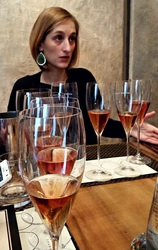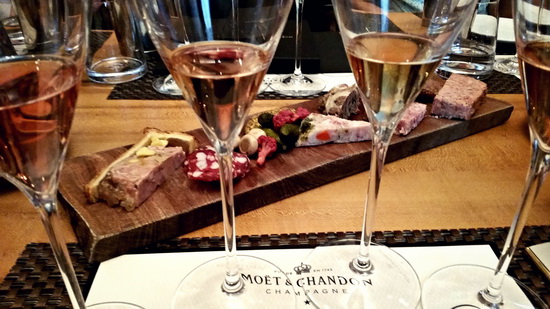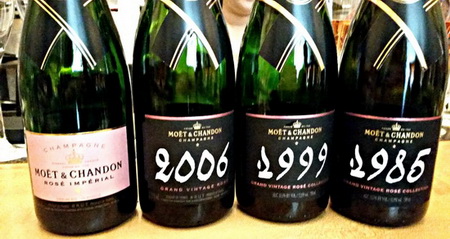By Melissa Pulvermacher
Moët & Chandon is one of the world’s leading producers of Champagne. Moët produces more than 26,000,000 bottles of Champagne on an annual basis.
 Elise Losfelt, one of the 10 winemakers of Moët & Chandon, joined a group of tasters in Toronto, Ontario to introduce the new release of the 2006 Rosé in Canada in December, 2015.
Elise Losfelt, one of the 10 winemakers of Moët & Chandon, joined a group of tasters in Toronto, Ontario to introduce the new release of the 2006 Rosé in Canada in December, 2015.
Elise helped the tasters understand that behind the label and well-recognized brand, there is a product and that the winemakers are extremely dedicated to achieving the expected style, while exceeding quality and expectations of its consumers.
The tasting began with the Rosé Brut Imperial, which is a non-vintage Champagne, meaning the final product is a blend of different vintages in order to achieve and maintain a consistency from year to year and ensure that a reliable product would always be available.
Vintage Champagne is only produced in the best years. Moët began producing vintage Champagne in 1842 and there have only ever been 40 grand vintages produced since then. This stresses how important ideal conditions in vintage variance is for the winemakers of Moët.
The Imperial’s intention is to deliver a consistent product that should taste the exact same every time, no matter where or when it is opened.
With primary notes of strawberry on the palate, the fresh fruit and textural component of the wine really shine through. The bubbles are fine and delicate and the light toast characteristics make this Rosé an extremely versatile wine.
If the intention of a non-vintage Champagne is to protect consistency, a vintage Champagne’s intention is to showcase the year on the bottle. Every vintage should be a different experience every time; it should be unique and rare in a desirable way.
Elise stressed the rarity of a vintage wine as 95% of all Champagne is non-vintage.
We began the vintage tasting with the 1985 Rosé. This wine was sophisticated and complex. It stayed on its lees for 21 years and was disgorged in 2006.
The fresh fruit characters have matured into a more evolved palate with an added nuttiness, cooked plum fruit character and layers of acidity and structure. The earthy palate and evident lees characteristics added to the maturity and pleasantry of this wine. The bubbles were still present and delicate as this wine really exemplified Moët’s ability to age and evolve.
 The 1999 vintage Rosé was disgorged in 2013, which is the primary reason for its fruitiness and fresh palate. The aromas have evolved with dried rose petal characteristics, but the minerality of the wine shines through on the palate. This wine had great complexity and showed both the potential for aging, as well as the long-lived freshness and vibrancy of this refined Champagne.
The 1999 vintage Rosé was disgorged in 2013, which is the primary reason for its fruitiness and fresh palate. The aromas have evolved with dried rose petal characteristics, but the minerality of the wine shines through on the palate. This wine had great complexity and showed both the potential for aging, as well as the long-lived freshness and vibrancy of this refined Champagne.
The tasting really focused on the 2006 vintage’s upcoming release. The 2006 Rosé, the youngest on the market, exuberant vibrancy with its energetic bubbles and explosive palate of fresh cranberry and strawberry with dried floral notes.
Disgorged in only 2013, the lees contact left a fresh bread character on the palate of this Champagne and a captured energy in this youthful wine. With a real precision, balance and harmony, the 2006 Rosé is expected to age incredibly well.
The tasting concluded as Elise reiterated that “Champagne is really about pleasure. If you make a connection with the wine, you won’t ever need your notes to remember it”.
Melissa Pulvermacher
 Melissa Pulvermacher is an inspired wine enthusiast educated through The Wine & Spirit Education Trust. Melissa is an active feature columnist with Natalie MacLean and writer for her own website – Recipes and Red Wine.
Melissa Pulvermacher is an inspired wine enthusiast educated through The Wine & Spirit Education Trust. Melissa is an active feature columnist with Natalie MacLean and writer for her own website – Recipes and Red Wine.
In addition to her writing, Melissa acts as a Sommelier in Guelph, ON, a freelance wine consultant and founder of The Vino Enthusiasts Wine Club in Southern Ontario. Melissa intends to fully commit to a life-long journey in the education and appreciation of wine.








